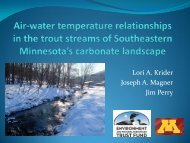Minnesota Water Resources Conference - Water Resources Center ...
Minnesota Water Resources Conference - Water Resources Center ...
Minnesota Water Resources Conference - Water Resources Center ...
Create successful ePaper yourself
Turn your PDF publications into a flip-book with our unique Google optimized e-Paper software.
Concurrent Sessions I 10:00–11:30<br />
Track D: Biologic Integrity of Streams<br />
BOOK OF ABSTRACTS<br />
Tuesday, Monday, October 27 23<br />
Determination of Appropriate Metric(s) for Sediment-related Maximum Daily Loads (TMDLs)<br />
Anne Lightbody, University of <strong>Minnesota</strong>, annel@umn.edu; Partick Belmont, University of <strong>Minnesota</strong>; Jeff Marr, University<br />
of <strong>Minnesota</strong>; Cailin Orr, University of <strong>Minnesota</strong>; and Chris Paola, University of <strong>Minnesota</strong>, cpaola@umn.edu<br />
The most common cause of impaired rivers and streams in the United States is sediment pollution. Sediment<br />
impacts on stream systems result from both its effect on water clarity and its physical characteristics. High<br />
levels of fine suspended sediment reduce aquatic health in numerous ways, including a reduction in light<br />
transmission, interference with aquatic organisms, and reduction in benthic habitat quality following<br />
deposition on the bed. There are many ways of measuring suspended sediment levels, including both direct<br />
measurements of concentration and indirect measures such as turbidity. Measurements of total suspended<br />
solids concentrations are obtained from water samples, which are then filtered and processed in a laboratory.<br />
Turbidity, on the other hand, is an expression of the optical property of a sample of water, in which the<br />
amount of light scattered by a given water sample is compared with that scattered by a standard sample.<br />
In many systems, particle size characteristics change rapidly both temporally and spatially, so turbidity<br />
does not always correlate well with suspended sediment concentrations. Therefore, since <strong>Minnesota</strong> has a<br />
water quality criterion based on turbidity alone, it is possible that stream habitat quality is being reduced by<br />
sediment pollution effects that are not captured by an analysis of water clarity alone.<br />
Here, we asked the question of what is the most important aspect of sediment pollution. We tested the null<br />
hypothesis that turbidity is the most important factor by experimentally manipulating turbidity levels within<br />
an outdoor stream ecosystem and observing impacts of turbidity on this system. We introduced water with<br />
different compositions of suspended load (e.g., different proportions of fine sand, silt, mud, and different<br />
levels of organic matter and nutrients) but the same turbidity level into the Outdoor StreamLab facility at St.<br />
Anthony Falls Laboratory (SAFL), and compared the ecosystem response. Trials were performed under high<br />
flow conditions, which often accompany high turbidity levels and typically exert substantial stress on aquatic<br />
ecosystems. The results were analyzed to determine whether turbidity (i.e., NTU) most closely correlates<br />
with benthic habitat quality, or whether another metric or combination of metrics (e.g., suspended sediment<br />
concentration, transparency, net sedimentation, or embeddedness) provides a better understanding of<br />
the effect on benthic habitat. These results are needed by federal and State agencies to modify their TMDL<br />
program and better protect the water quality of America’s rivers and streams.<br />
Relation of Nutrient Concentrations and Biological Responses in <strong>Minnesota</strong> Rivers: Implications for<br />
River Nutrient Criteria Development<br />
Steven Heiskary, <strong>Minnesota</strong> Pollution Control Agency, steven.heiskary@pca.state.mn.us; Howard Markus, <strong>Minnesota</strong><br />
Pollution Control Agency<br />
The <strong>Minnesota</strong> Pollution Control Agency recently completed promulgation of in-lake nutrient standards and is<br />
required by U.S. EPA to develop nutrient standards for rivers as well. This requirement led to several studies that<br />
demonstrated significant and predictable relationships among summer nutrient, chlorophyll a, and biochemical<br />
oxygen demand (BOD) in several medium to large <strong>Minnesota</strong> rivers. In an expansion of this work in 2000, diurnal<br />
dissolved oxygen (DO) flux (based on submersible data recorders) was found to be strongly positively correlated<br />
to TP and chlorophyll-a concentrations at several stream sites. These findings led to an expansion of this work<br />
on several additional rivers in 2006 in conjunction with USGS. These results, combined with those from 2000,<br />
demonstrate significant relationships among several invertebrate and fish metrics and TP, TN, chlorophyll-a<br />
and DO flux. Observations from these studies will be shared and their implications for development of river<br />
nutrient criteria discussed.<br />
<strong>Minnesota</strong> <strong>Water</strong> <strong>Resources</strong> <strong>Conference</strong>, October 27–28, 20078 22
















